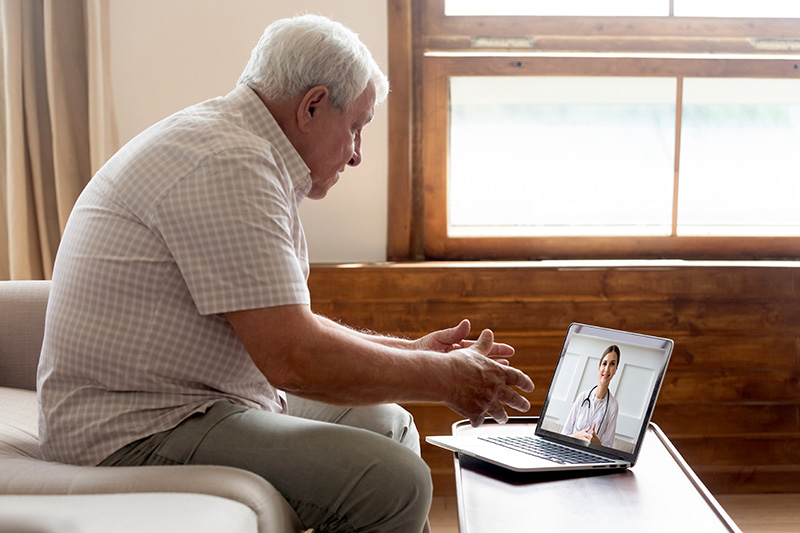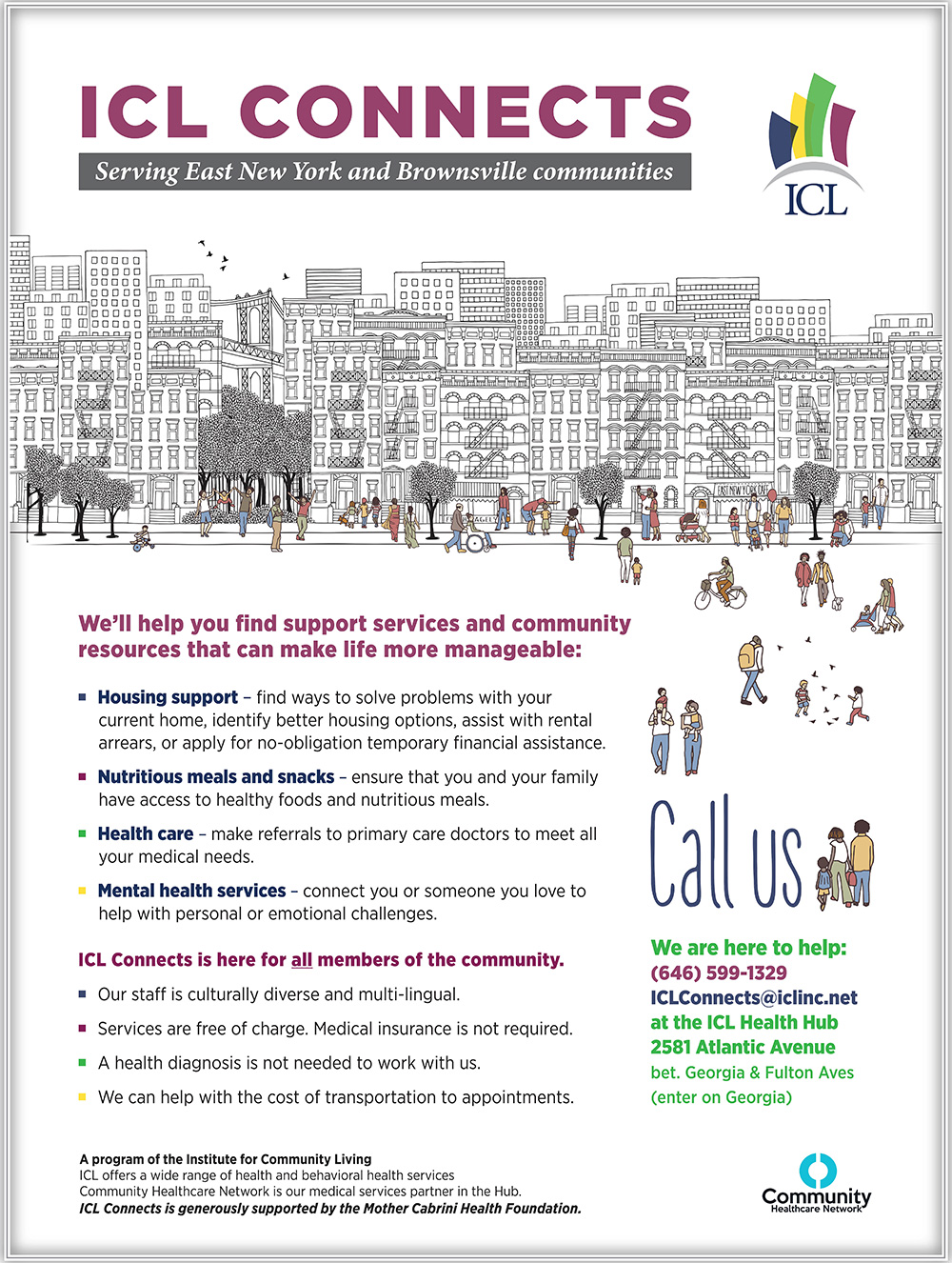Since the pandemic took hold just over a year ago, behavioral health entities had to adjust almost overnight to virtual care to ensure that services were not interrupted, especially for our most vulnerable populations. For many of these clients, in addition to the help they receive for their mental health challenges, ICL works closely with each individual client to address their physical health issues which are often significant for people living with mental illness.

So, we quickly got to work the weekend the shutdown began; the IT department preparing some 400 laptops so that on Monday morning, there was a seamless transition to virtual services.
We’ve learned a lot from this use of telehealth services. Beyond being an effective short-term solution for continuing care during a pandemic, use of telehealth this way has given clinicians another viable route to help more vulnerable clients in their recovery and achieving greater health and well-being. Of course, telehealth is one among a set of clinical tools — vehicles that drive goal attainment for everyone we serve.
While it will take many months – and even years – to assess the full impact of the pandemic on behavioral health services, one thing is clear: our reliance on Zoom and other technologies for providing care for the provision of care is not disappearing. Use of telehealth will serve the field well as we confront the other pandemic – the tremendous rise in mental health challenges for much greater segments of the populations, particularly young people.
Even as we begin to return to some aspect of life as we knew it, there will be no going back to the pre-pandemic way of doing business – whether in providing mental health support or managing day-to-day operations of an organization or business.
Lessons of a Pandemic
Whether communicating virtually with clients or colleagues, we need to talk about it: what isn’t working, and more importantly, what is. During the pandemic and beyond, we want to minimize the pitfalls and leverage the strengths of different forms of technology to accomplish our ultimate goal: Helping one another be better, feel better, and live better.
While we know the Zoom “revolution” could become a real force for change, it’s critical that we understand the implications for practice as well as about access and suitability for different client populations. So too must we build in protections to ensure that the highest quality of care is offered through remote services. That includes collecting and carefully evaluating information and data on the efficacy of the use of remote video in behavioral health.
The implications for clinical practice are many. ICL is embarking on a training program for staff to understand and implement best practices in the context of offering care virtually.
It’s critical that we not allow virtual services become a barrier to achieving the promising outcomes ICL has realized with the enhanced use of integrated care that has led to improvements in health and mental health for our clients and for the larger community, this use of whole health care has resulted in reduced hospitalizations for mental health and physical health reasons and enhancing the overall and longer term well-being of the people we serve.
While our shift to offering care virtually was quick, its continued use has been done very thoughtfully. From early on in the pandemic, we have been looking at how telehealth is impacting clients and services. Here are some of the early lessons for practice from the use of telehealth throughout our programs:
Creating safe spaces: In all ways of providing services, we know we must maintain confidentiality as well as comfort – professionalism while providing a sense of structure and warmth and an appropriate level of self-disclosure. Most challenging for the use of telehealth is the fact that clients cannot always log on to video or phone chat from spaces that are confidential or comfortable.
Practice suggestion: From the start, solicit client feedback about comfort and safety, and strategize together how to maximize these factors.
Cues and signals: On Zoom, if much of a client’s body is out of frame, while we can focus on facial expressions, we’re missing out on their body language and therefore much of the story. Facial cues themselves can be more difficult to discern; for example, we might not notice a client blinking back tears, or because of camera position, we might misinterpret shifts in a client’s gaze. Auditory cues, such as sighs and sniffs, can also be more difficult to pick up on and interpret, perhaps more so than during telephone sessions where the auditory connection can feel more focused and intimate. Of course, we cannot pick up on olfactory cues on virtual sessions – at least not yet.
Practice suggestion: If you can’t see (or hear) something, say something! It’s okay and encouraged to ask: “How are you sitting right now?” Be candid about the fact that it’s more difficult to pick up on certain cues on video chat. Check in often. It might be useful to ask how they are perceiving you, and to explore how your own non-verbal cues are experienced.
Staying present remotely: Scientific research shows that our brains have to work on overdrive to process what we communicate to one another via videoconference. This may make it more difficult to relax into the rhythm of a session. Many of us may feel a heightened awareness that we are being viewed on a video session, which can be distracting. There is also research showing that staring at a screen for long periods of time can lead to eyestrain, headache, and tension – all of which can significantly detract from the efficacy of the session.
Practice suggestion: Minimize your own image on Zoom if it’s distracting, and if things feel labored or awkward, call this into the session. To encourage present-moment awareness for both practitioner and client, consider incorporating meditation or mindful movement, with eyes closed or looking away from the screen. If possible, try to structure workdays so that breaks in between client sessions need not all be spent looking at the computer.
At ICL, relationship-building is central to everything we do to support people on their road to recovery and leading a healthier and more productive life. These relationships can be healing and transformative for participant and practitioner. We know that in-person work will always retain a very important place in what is and must continue to be a person-centered field. At the same time, we are in an exciting juncture for the profession as all of us together as a community and individually as organizations, explore how we can sustain the benefits of relationship-building using nontraditional channels.
We’ve learned a lot from the use of virtual care provision. While it was first seen as a short-term change, the use of telehealth services has opened up new ways to reach our most vulnerable populations for the longer term while always recognizing the centrality of relationship-building and other longstanding approaches to helping us get people better
Survey Shows Acceptance and Success
The promise of telehealth is clear to many of us as clinicians; what was less expected was the extent to which our clients embraced virtual care. In May, 2020, individuals receiving services from ICL behavioral health programs were asked to participate in a survey, the results and its implications for the use of tele-psychiatry published in an article of APA Journal of Psychiatric Services. What we learned was that 80% of the almost 1,500 respondents reported satisfaction with care and interest in continuing these services in the future, even when the pandemic lifts. The majority of those feeling favorable toward telehealth wanted telehealth to be in combination with in-person services.
As we continue to track clients receiving support via telehealth, there will be much more to learn and share with the community, just as their experiences can help us moving forward. We all share the goal of making these services as effective as possible.
Advocacy is Key to Future of Telehealth
Virtual forms of care were immediately put into place by agencies across the five boroughs. But at the same time, it was clear that making this shift – and other needed adjustments to the pandemic – was going to be very costly to our organizations. And while telehealth showed great promise for the care of the people we serve; government would have to make more permanent changes around reimbursement and regulations for behavioral health organizations to effectively use telehealth longer term.
In their Budget Priorities for FY22, the Coalition for Behavioral Health said that COVID-19 “is an unprecedented financial threat to community service providers.”
The Coalition supported the executive proposal to “maximize movement to telehealth, allowing individuals to receive care where they are located.” But advocates also made clear two key ways the executive proposal fell short: rate parity and the need to cover telehealth at the same rate as in-person services and peers: making those peers eligible for reimbursement for in-person series eligible for telehealth reimbursement; they have proven to be an important part of treatment and recovery and should not be treated differently from other professionals.
All of us in the behavioral health field will watch closely as the state budget negotiation process moves on these issues and legislators and the governor agree to a final budget; by law it is to be finalized by April 1st. Stay tuned.






